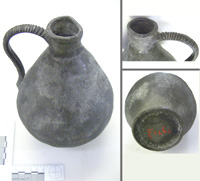Pewter flagon

Click ^ for larger image.
This is one of three beautiful and rare Roman survivals found 8.5m (28 ft) to 10m (32 ft) deep in the well amongst other material. They are made from pewter which is a metallic material, the composition is lead 62.5%, tin 36%, antimony 0.8%, "earthy matter" and possible loss 0.7%. The powdery white patches on the surface is lead oxide from the lead/tin alloy. Drinking from these could have had serious health implications; ie lead poisoning.
The jug has a narrow neck opening and small base. It has a decorated handle in the form of ridges on the outside surface and smooth on the inside. The decoration of the handles resembles bronze work of the same period.
Found in the well at Brislington Roman villa site during the development of what is now Winchester Road in December 1899. The villa is contemporary with several others in the region, built about AD 270 as a working farm with workshops until destroyed by fire about AD 370.
Photographs exhibited with kind permission of Bristol Museum and Art Gallery, which has this in its collection (reference number F1264).
Material: metal
Period: Romano-British
Find spot: Winchester Road, Brislington. ST 616709
Exhibit contributed by Bristol Museum and Art Gallery
Text written by Dawn Witherspoon, 2012
Photographer: Ken Taylor
Acquisition number: 120316a6